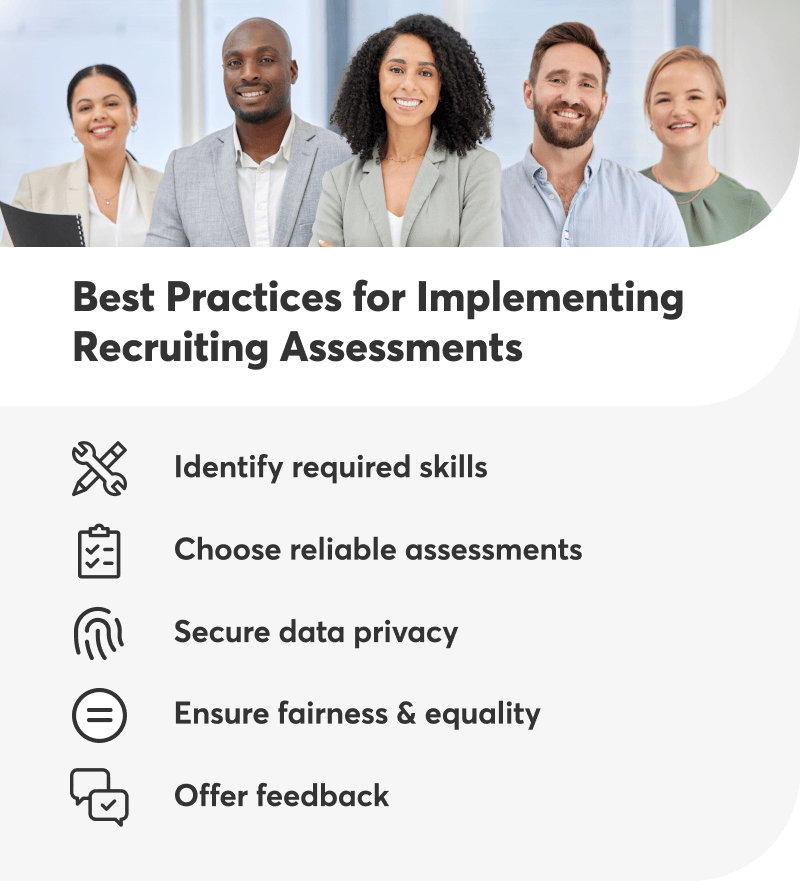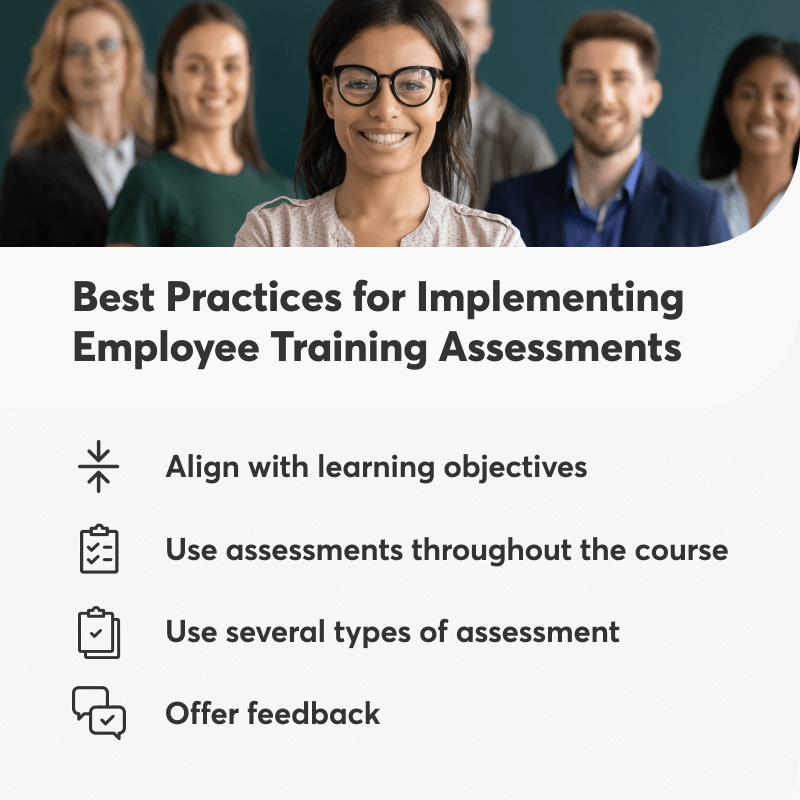Table of Contents
Candidate evaluation has become more intricate over the years. Previously, as a recruiter, you usually held an interview where the candidate discussed their resume and formal qualifications and maybe you gave them a take-home assignment too.
Now, the hiring process includes advanced assessments, like psychometric tests and behavioral interviews.
This shift is largely due to the increased need for soft skills as well as technical skills. Employers understand that critical thinking and emotional intelligence, to name a couple, are just as important for a functioning workplace as degrees and certifications.
Advanced assessments are also an integral part of online training, enabling your HR team to gauge the effectiveness of L&D initiatives and tweak your strategies to address training needs and learning preferences better.
By doing so, you can close skills gaps in your organization in a more cost-efficient and effective way.
In this post, we’ll do a deep dive into the role of assessments in candidate screening and training evaluation alike, we will also provide you with concrete examples and best practices as well as a brief overview of the LearnWorlds Assessment Builder.
Table of contents
- 1The Role of Assessments in Candidate Screening
- 26 Types of Assessments Used in Candidate Screening
- 3Best Practices for Implementing Recruiting Assessments
- 4The Role of Assessments in Employee Training Courses
- 57 Types of Assessments Used in Employee Training
- 6Best Practices for Implementing Employee Training Assessments
- 7The LearnWorlds Assessment Builder
- 8Case Studies: Real-World Examples of Successful Assessments With LearnWorlds
The Role of Assessments in Candidate Screening
The cost of a bad hire is high, reaching up to 30% of the employee’s first-year earnings! Therefore, it makes sense that companies will go the extra mile to ensure they get it right the first time around.
Let’s see this and more benefits of using advanced assessment for candidate screening.
Speed up the recruiting process: For job positions that require strong or specialized technical skills, starting with a brief job-related assessment can really speed up the hiring process and free up time for your HR team.
Streamline the recruiting process: Similarly, assessments help streamline the recruiting process and make sure it’s fair and equal, provided that all candidates complete the same assignment.
Find the most qualified person: It’s important to assess technical skills during the hiring process to make sure you find the most qualified person who can keep up with the job requirements and contribute to improving the team’s performance and productivity. This helps you build stronger, happier teams with less friction.
Make unlikely hires: In some cases, an assessment may help you find that a candidate fits better in a different job position than the one they had originally applied for. Not only you saved the company from a bad hire, but you also enhanced the team talent distribution!
See if the candidate is a good cultural fit: Assessments increase the chances of hiring the best person, not only in terms of typical qualifications but also cultural fit. Assessments focusing on personality traits, beliefs, and values will pinpoint the person that best aligns with your company culture and “clicks” with your team.
Allow candidates to self-evaluate: During an assessment, candidates also get to evaluate themselves. They might find that they don’t have the required skill level or that the daily tasks involved are not what they expected.
Reduce employee turnover: New employee turnover is surprisingly high – 20% of new employees will quit within the first 45 days. By giving candidates a glimpse into the actual tasks and measuring competencies and cultural fit, assessments can be very effective in preventing early turnover from happening.
6 Types of Assessments Used in Candidate Screening
So, what type of assessments can your HR team deploy to evaluate job candidates and cut through the noise? Assessments may vary depending on the job requirements, but the following are the 6 most reliable and commonly used assessments for candidate screening.
#1 Skills assessments
Skills assessments evaluate the candidate’s job-specific skills. They can take different forms depending on the job role. For example, a graphic designer will be requested to deliver a design based on specific requirements, while a copywriter might create a draft for a landing page or write a promotional email.
Skills assessments are usually take-home assignments – unless they’re really brief, and you need to ensure that the candidate can work under pressure.
You have several options to assign a skills test, like a candidate assessment platform, a Learning Management System, or even a collaboration platform with simple file-sharing capabilities. You can additionally set time limits, accept written, video, or audio assignments, and send back personalized feedback.
#2 Behavioral interviews
Behavioral interviews are perhaps the most common assessment used in candidate screening. They include questions about the candidate’s past work experiences and specific examples of them handling certain situations at work.
The questions are open-ended and have the form “Tell me about a time when…”. The interviewer usually follows up with more questions to understand the candidate’s thought process. The reasoning behind behavioral interviews is that past behavior is indicative of future behavior.
Behavioral interviews can be very helpful in identifying whether a candidate aligns with the company’s work ethic and culture, as well as their overall behavior, communication style, problem-solving and decision-making capabilities, and approach to conflict management.
#3 Situational judgment tests (SJTs)
In contrast to behavioral interviews that concern events that have already taken place, situational judgment tests present the candidate with a hypothetical scenario to gauge how they would react or approach a situation.
They serve the same purpose as behavioral interviews, but they can have a different format if you wish. Apart from open-ended questions, SJTs can also be a set of multiple-choice questions.
While that sounds easier, multiple-choice questions are actually more complex as they aim to put the candidate in a dilemma between different courses of action.
#4 Cognitive assessments
Also known as cognitive ability or aptitude tests, cognitive assessments evaluate a candidate’s cognitive capabilities, like verbal/numerical reasoning, logical reasoning and memory, and information-processing speed and analysis. Ultimately, they aim to measure the candidate’s problem-solving and decision-making capabilities.
Cognitive assessments are usually time-constrained as recruiters need to see how the candidate performs under pressure. Since cognitive abilities are complex and hard to measure, HR teams use standardized tests, like the Criteria Cognitive Aptitude Test or the Wonderlic Test, to ensure the validity and accuracy of the assessment.
#5 Personality/Psychometric assessments
Personality and psychometric assessments are also standardized, with the most popular examples including Myers-Briggs Type Indicator (MBTI), the Big Five Personality Traits assessment, and the DISC assessment.
They aim to evaluate personality traits and behavioral tendencies to predict whether a candidate is a good fit for the team and whether they possess the soft skills required, like how they handle crises, navigate conflict, or interact daily.
#6 Cultural fit assessments
Still on the non-technical skills topic, cultural fit is another key indicator of whether a new employee is built to last in the workplace.
Work ethics, values, and behavior that match company culture are essential for every new employee entering your door.
In cultural fit assessments, recruiters usually present employees with work-related scenarios to see how the candidate would handle the situation (STJs) or ask behavioral questions to see how they have handled certain situations in the past.
Another commonly used method to evaluate cultural compatibility is listing a set of values that are important to the company (like integrity, teamwork, work-life balance. etc.), and asking the candidate to rate or rank them.
Best Practices for Implementing Recruiting Assessments
Now you know the importance of using assessments during recruitment and the most tried-and-tested types of assessments – time to see how you can integrate those effectively into your candidate selection process.

Identify the skills required
Before building or choosing your assessment, it’s important to identify the key competencies and skills required for the position. It’s no use in going overboard and bombarding candidates with multiple assessments that may not even be relevant to their job role or don’t effectively evaluate the skills they need to showcase.
Be very clear about which skills, both technical and otherwise, are required for the position, then start working on your assessments.
Choose reliable assessments
Whether you create your own assessments or use ready-made ones, you need to ensure they are reliable and accurately measure the relevant competencies.
For soft skills, choose standardized, reputable tests that are widely used by HR professionals.
Job-specific and technical skills assessments should be created by an expert or a manager who knows exactly what the job entails. You can create your own advanced assessments if your Learning Management System supports this option.
Secure data privacy
During recruiting, a lot of sensitive data circulates. Contact information, physical and email addresses, and much more are shared with the company.
Every single tool where this data enters, from your recruiting platform to the company website, should comply with data safety regulations.
An additional measure is to ensure that everyone who has access to sensitive data has undergone vigorous cybersecurity awareness training.
Ensure fairness & equality
Every candidate should receive the same assessment according to the requirements of the specific job role. Using standardized tests with pre-set scoring systems helps ensure that the assessment and evaluation criteria are fair and objective.
Interviews can be more tricky, though. Start by training your hiring teams on bias awareness and diversity & inclusion – this will give them a basic understanding of unconscious biases.
If possible, make sure your interviewing team is diverse, with people of different gender, backgrounds, and cultures so that they can offer multiple viewpoints.
Provide feedback
When the screening process is over, and you’ve evaluated the candidate’s assessment, take the time to reply to the candidate. Inform them of your decision and provide feedback explaining why they were or were not chosen for the job.
Candidates will appreciate any feedback they receive as long as it’s constructive and enables them to do better in their next job interview.
The Role of Assessments in Employee Training Courses
Coordinating employee training initiatives is another key task for your HR team, right? Assessments are important here, too, for the following three reasons:
Uncover & address skills gaps: Taking place before a training program, pre-assessments help you gauge the overall and individual knowledge levels of employees.
This will help you build courses that effectively address the skills gaps in your organization and also guide each employee toward the best courses for their skill sets and career goals.
Increase knowledge retention: By incorporating assessments into a training course, you offer employees opportunities to visit their memory banks and reinforce their knowledge through repetition and active recall.
At the same time, instructors and training managers can identify struggling learners and reach out to them for help or to revise their training plans.
Measure training effectiveness: Assessments are also an accurate way to measure employee knowledge after the training is completed and, alongside, the effectiveness of your training program.
If employees didn’t manage to achieve the desired learning objectives, your training course is not hitting the mark and needs to be improved.
7 Types of Assessments Used in Employee Training
Assessments are an integral part of employee training, from start to finish. Let’s check out seven of the most popular types of assessments to choose the ones that will better address your training needs.
#1 Pre-assessments
Pre-assessments are an essential part of employee training, but they’re often overlooked. This results in most companies offering generic training courses without having identified the skills gaps in their organization.
To avoid wasting the company budget and your employees’ time, conduct pre-assessments to evaluate the overall skills gaps status in your company and address each employee’s unique needs.
During pre-assessments, encourage employees to discuss their career goals and the skills they feel they need to enhance.
#2 Knowledge assessments
Multiple-choice quizzes, open-ended questions, and true/false questions are typical examples of knowledge tests that are placed throughout the course or at the end of it to measure employee understanding and progress.
This type of assessment is the most commonly used, and it’s a good way to boost knowledge retention, but it is not entirely accurate in predicting the employee’s ability to put what they’ve learned into practice. For the latter, you need to deploy a skills assessment.
#3 Practical/Skills assessments
Skills assessments are more practical in nature and focus on real-world applications rather than theoretical knowledge. They’re particularly common for job-specific tasks and are the most accurate way to evaluate employees while they’re still in the training phase.
Common skills tests include hands-on demonstrations of practical tasks (like operating equipment or using a software tool) and role plays or simulations.
#4 Self-assessments
Self-assessments are non-graded assessments that take place any time during the training or before as a pre-assessment.
They can be open-ended or closed-type questions, while they often include self-reflection activities prompting the learner to go back to their performance and evaluate their approach.
Self-assessments can significantly improve the employee’s learning process, so make sure to include them in your training courses.
#5 On-the-job observations
Usually taking place either as part of a pre-assessment or as a post-training evaluation, on-the-job observations enable managers and supervisors to evaluate how the employee performs, whether they’re able to apply their newfound skills on the job, and identify areas for improvement.
#6 360-degree assessments
360-degree assessments are the most comprehensive types of assessment that, similar to on-the-job observations, usually take place before or after training to gauge employee skill level.
They include on-the-job observations, self-assessments, and interviews with the employee and their colleagues.
#7 Evaluation surveys
Evaluation surveys measure, first and foremost, the overall effectiveness of the course from the perspective of the employees. Ask employees to share their experience with the training program, make suggestions for future courses, and anything else you want to know.
Apart from surveys, you can collect employee feedback through one-to-one interviews.
Best Practices for Implementing Employee Training Assessments
Let’s see how you can best incorporate assessments into your employee training strategy.

Align with learning objectives
Training assessments should be relevant to the learning objectives of the course. When writing your lesson plan and before building your assessments, think about how this particular type of assessment will help you measure employee knowledge or skills.
For example, technical skills are best measured through practical assignments and closed-type questions (for a quick knowledge check) while soft skills can be effectively measured via a role-play exercise.
Use assessments throughout the course
Incorporating assessments throughout a training course offers employees the opportunity to self-reflect and helps them retain information.
Even quick multiple-choice quizzes can be beneficial in enhancing knowledge retention and keeping employees motivated.
Use several types of assessment
Building a variety of assessments is necessary not only to address the requirements of different learning objectives but also to accommodate accessibility issues.
A learner with dyslexia, for example, should be able to submit a video or audio recording instead of a written assignment or conduct an interview.
Offer feedback
Each assessment should be accompanied by feedback, be it automated or personalized. For complex assessments, we definitely suggest offering detailed, personalized feedback that will help the employee understand what they need to work on.
The LearnWorlds Assessment Builder
Not all LMSs are created equal, especially when it comes to essential features such as assessments. We’ve got some good news, though!
LearnWorlds enables you to build graded assessments (exams), non-graded assessments (self-assessments), and surveys that you can use in all your HR processes as you see fit.
For exams, the following types of questions are available:
For self-assessments, most of the exam questions are available, in addition to a reflection journal.
You can also use LearnWorlds’ Form learning activity to build evaluation surveys for your course.
Advanced options
Real-World Examples of Successful Assessments With LearnWorlds
We’re glad to find that our customers are making the most of our rich assessment builder and have added assessments to their corporate learning strategies. Let’s see just a couple of examples to get you inspired!
💼 Employee training
A client running one of the largest companies in the food manufacturing industry in Greece has chosen to deploy their health & safety program using LearnWorlds.
To make assessments more fun for their learners, they have deployed a gamification strategy, offering a badge for every successful multiple-choice quiz completed.
🕵️ Candidate screening
Another client in the UK finance & investing sector is using role-specific simulations during recruiting to assess the candidate’s decision-making skills.
The candidate watches an interactive video with animated characters and dialogue, and they need to reply to pop-up questions that appear during the video.
Final Thoughts
Advanced assessments can make a huge difference for your HR team. You can literally speed up the hiring process, find the best fit for the job, and evaluate training effectiveness with this powerful tool.
Investing in an LMS that supports advanced assessments will help you use fewer tools, connecting employee hiring and training. Use just one platform to deploy training and evaluate job candidates with multiple types of assessments that you can build on your own.
If you haven’t tried LearnWorlds yet, take advantage of our 30-day free trial now! LearnWorlds is the best LMS to deploy employee training at a scale with rich features and support for all learning delivery methods, including mobile learning with your own branded mobile app.
9000+ brands trust LearnWorlds to train their people, partners & customers.
Start a FREE TrialFurther reading
- The 19 Best Learning Management Systems
- 10 eLearning Trends
- SCORM 101: The Definitive Guide to Choose a SCORM-Compliant LMS
- The Essential Guide on How to Create Cohort-Based Courses
- 10 Best WordPress LMS Plugins Comparison
- What is an LMS (Learning Management System)?
- The Mobile Learning Approach: What is it And What Are The Benefits?

Androniki Koumadoraki
Androniki is a Content Writer at LearnWorlds sharing Instructional Design and marketing tips. With solid experience in B2B writing and technical translation, she is passionate about learning and spreading knowledge. She is also an aspiring yogi, a book nerd, and a talented transponster.



